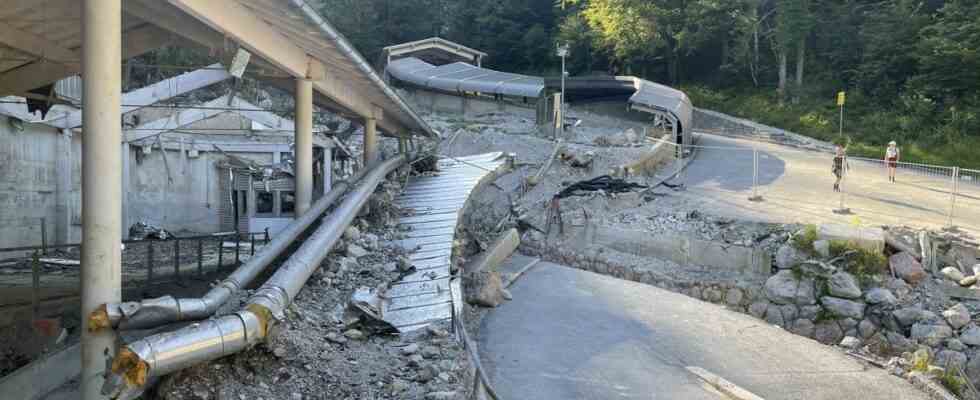It almost hit the roundabout too. Where spectators used to be able to let the tobogganists and bobsled race around them, a fence made of thick wire rope has held back the debris. Its steel supports lie here rather than stand upright. But they and the whole fence are still resisting the pressure of the stones and logs washed up, the water has only gnawed at the asphalt of the path. The rough concrete of the track, which has been ice-free for so long, remained intact here, only here and there dandelions grow out of the joints. The debris doesn’t come until further up, at turn six. At the very top, where the train has crossed a paved ditch after a first right-hand bend, there is nothing left of it.
There, the oldest artificial ice rink in the world, the Eiskanal am Königssee, fell prey to the masses of water and debris that the Klingerbach washed away from the Grünstein after heavy rain more than a year ago. It is still unclear when it will be rebuilt.
After that night on July 18, 2021, when the upper part of the bobsleigh track was to be built, most of the people here in the basin, the district councilors of the Berchtesgaden region and the politicians from the state and federal government who had arrived in a hurry, quickly agreed that it should be rebuilt at all buried under rubble, boulders, timber and rootstocks. Just a few days ago, the local CSU member of the Bundestag and ex-Minister Peter Ramsauer once again emphasized how important the railway is for the region, in economic, sporting and tourist terms. The 53 million euros from the federal government for reconstruction are ready. Bavaria’s Interior Minister Joachim Herrmann (CSU) was just back. One is on the right track, he said afterwards – but there are also doubts that it is really the right one.
The ÖDP, for example, considers the entire railway to be “out of date” in view of climate change, a shortage of raw materials and the energy crisis. It only serves a niche sport, it said at the party’s most recent district meeting. The ÖDP sees all the ideas of operating the ice track, which is quite energy-intensive because of the cooling, in future in a climate-neutral manner with green electricity from the new energy company of the five valley basin communities as “greenwashing”.
The district group of the Federal Nature Conservation Association has long since spoken out against the construction and recalled that the Klingerbach had already caused major damage in 1975 and the flank of the Grünstein was already considered a geological risk zone when the railway was last expanded in 2010. One provocative suggestion was that the intact part could be made into a “monument to the effects of natural forces”.
In winter, a makeshift training operation could start
How great these forces can be can be imagined by following the Klingerbach a little further uphill and encountering concrete rubble and crumpled walls made of wire mesh and stones. A geologist is currently investigating whether the Grünstein and the Klingerbach could be tamed more effectively in the future. According to Mayor Hannes Rasp (CSU), it is already becoming apparent that a renewed railway will no longer cross the stream. The male tobogganists should therefore start on the same side of the stream as the women and all bobsleds.
Deputy District Administrator Michael Koller (FW) expresses the hope for the district as the owner of the railway that a makeshift training operation for the youth will be possible in winter. Because the German bobsleigh and sled association based in Berchtesgaden, which is used to success, fears that the youngsters will break away completely without a track. He hardly expects any races before 2024. Whether that will happen is an open question. It is already considered unlikely that 53 million euros will be enough for a renovation.

